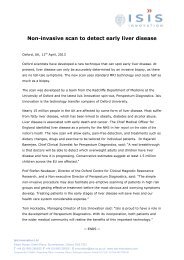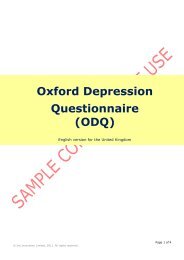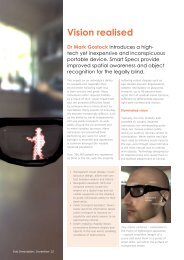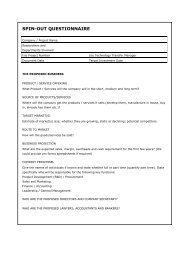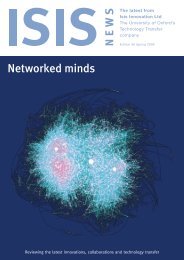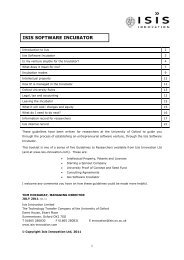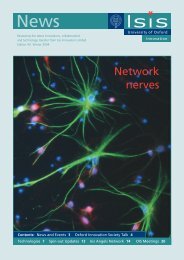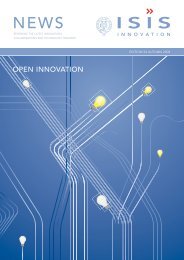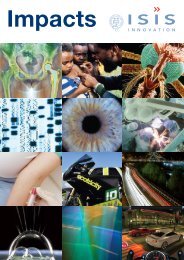CLIMATE CHALLENGE - Isis Innovation
CLIMATE CHALLENGE - Isis Innovation
CLIMATE CHALLENGE - Isis Innovation
- No tags were found...
You also want an ePaper? Increase the reach of your titles
YUMPU automatically turns print PDFs into web optimized ePapers that Google loves.
HIGHER EFFICIENCY MATERIALS FORLi ION BATTERIES<strong>Isis</strong> Project Number 2918New cost effective electrode materials viable for Li ion batteries, and supercapacitors having highercharge storage capacity, can power applications such as Hybrid Cars, Mobile Phones and Laptops.Marketing opportunitiesLithium ion batteries have led the demand in poweringportable devices, and their global sales are expected to reach$US5.0 billion by 2012. Lithium ion batteries outperform theconventional rechargeable batteries in life cycle and weightbut they are:Expensive: the battery electrodes are made from cobaltand manganeseDegrade in performance by 20% per annum due to thechanges in chemical structureThe rapidly increasing new applications have triggeredthe demand for new low cost electrode materials that canprovide high cell capacities, power and cyclability.The Oxford inventionThe Oxford battery materials are layered oxide chalcogenides.The active region in these newly synthesised materials issandwiched in-between the oxide layers. Here discharginginvolves full replacement of copper ions by lithium ionsand extrusion of elemental copper to the surface; charginginvolves removal of lithium and reinsertion of copper.The reversibility of the copper extrusion process has beenevaluated between 2.7 and 1.1 V, and nuclear magneticresonance spectroscopy was used to probe the lithiumenvironments and mobility.The layered oxysulfides Sr 2MnO 2Cu 2m-0.5S m+1(m= 1, 2, and 3)consist of alternating perovskite-type Sr 2MnO 2layers, whichconsist of single, double, or triple layers of CuS 4tetrahedraThe Layered Oxysulfides Sr 2MnO 2Cu 2m-0.5S m+1(m= 1, 2, and 3) for Li IonBatteriesfor the m = 1, 2, and 3 materials, respectively. Intergrowthsof these structures are also possible, and a material withalternating single and double copper sulfide layers has alsobeen prepared.These low cost electrode materials offer several advantages.A prototype battery constructed using these newly inventedmaterials as the positive electrode (cathode) shows:Low capacity fadeRobustness even after repeatedcharge/discharge cyclesHigher charge storage capacityPatent statusThis work is the subject of a UK patent application, and<strong>Isis</strong> would like to talk to companies interested in furtherperformance optimisation and commercialisation of thisopportunity. Please contact the <strong>Isis</strong> Project Manager todiscuss this further.contactDr Rakesh RoshanProject Manager, Technology Transfer GroupT 01865 280853E rakesh.roshan@isis.ox.ac.ukW www.isis-innovation.com12



